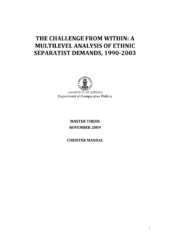| dc.description.abstract | This thesis aims to identify which factors that explain why ethnic groups raise separatist demands and what factors that are associated with a radicalization or de-radicalization of these demands over time. The topic is important in many respects. Separatist movements have the double potential of making a new state at the expense of breaking an old one and, in the worst case, being the cause of violent conflicts.The dynamic character of the phenomenon implies that one treats separatist demands as a broad theoretical concept operating along a spectre ranging from moderate to radical demands. I argue that a coherent and broad theoretical framework is needed. First, variables associated with the groups, such as ethnic distinctiveness, size, geographic concentration, political, economic and cultural discrimination, and external sources of power must be assessed. Second, contextual variables associated with the host states, such as institutional power sharing arrangements, regime type, regime durability, and state reputation must also be taken into consideration.The theoretical framework is comprised of two levels of actors, as the groups constitute sub-units within their host states. I have therefore used a multilevel growth curve regression model to test the theoretical hypotheses. This method of analysis is especially suited for handling a phenomenon that involves a nested data structure. The quantitative analysis was performed on data mainly from the Minorities at Risk and Quality of Government datasets, supplemented by data from Barbara F. Walter and Philip G. Roeder.The analysis supports the adoption of a two-level theoretical framework: Both factors related to the groups and the states are important for explaining separatist demands. Among the group-level characteristics, I found that political and cultural restrictions influence the likelihood of separatist demands, both positively and negatively. Also, if a group is concentrated geographically, the likelihood of the group becoming separatist is increased. Lastly, if a group has separatist or politically dominant ethnic brethren in neighbouring countries, this influences the likelihood of a group being separatist.Among the state-level variables, federal systems and autonomy regimes influences the likelihood of separatism. Regime durability also proved to be important, the longer a regime has survived, the more groups relax their demands over time. Finally, presidential systems are associated with a radicalization of separatist demands. What is most striking, both for group- and state-level predictors is that theoretically related variables' effects differ both in positive and negative directions, and with respect to explaining demands at the onset of the analysis as opposed to explaining change in these demands over time. | en_US |
